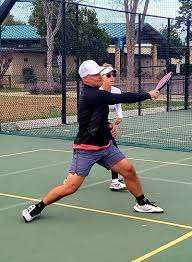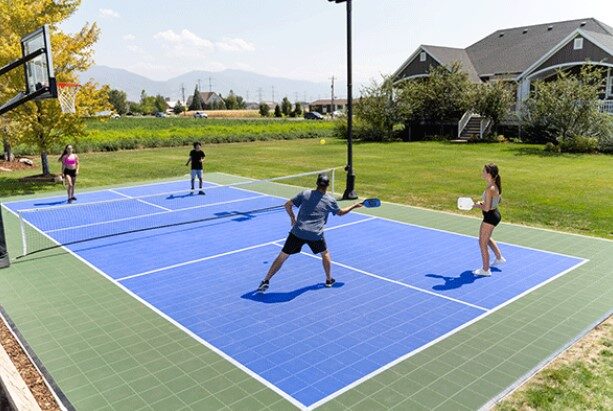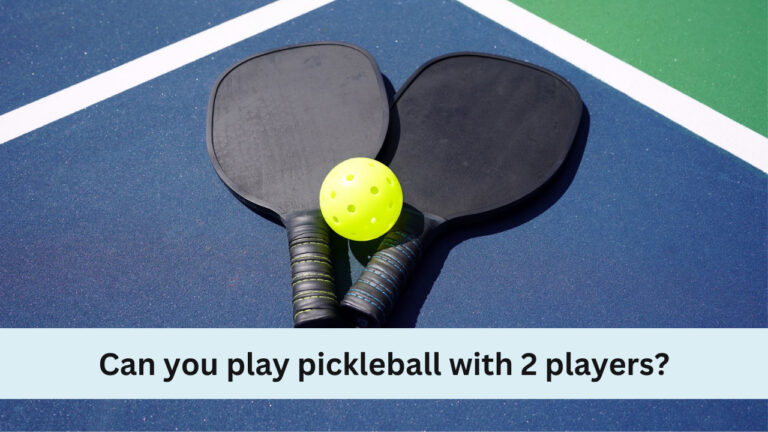Can you serve overhand in Pickleball?
Can you serve overhand in Pickleball? No, you cannot serve overhand in pickleball but you can hit the overhand shot. That means you cannot serve overhand to give a fair chance to return the ball. If you serve overhand it will be very difficult for other players to return the ball so it would not be a fair game. Let’s see what the rules say about it.
In pickleball, there’s a specific rule that says you must serve the ball underhand. The rule says, “The serve is made underhand. Paddle contact with the ball must be below the server’s waist.” This rule is simple but very important: it means that your serve must be done with your hand below your waist, and you can’t serve the ball overhand.
Can you serve overhand in Pickleball
Serving Rules:
In pickleball, players tend to be fair when it comes to serving rules, as long as the serve remains reasonable. Nevertheless, there are specific regulations concerning the serving motion that you might not be aware of. According to the IFP Official Tournament Rulebook, here’s what it states after reading this you will not only know that you can serve overhand in pickleball but also other necessary rules that you need to know.
The serve must be made with an underhand stroke so that contact with the ball is made below waist level (waist is defined as the navel level)
4.A. Serve Motion
While it’s widely known that serving in pickleball should not resemble the overhand serve in tennis, it’s not solely about avoiding the overhand motion. In pickleball, the crucial point is that the point of contact with the ball must be below the navel. If the paddle head makes contact with the ball above the navel, it’s considered a fault. Additionally, the serve must be underhand. But what exactly constitutes an underhand serve? This rule is clarified below.
“4.A.1. Underhand Defined. The arm must be moving in an upward arc and the paddle head shall be below the wrist when it strikes the ball (the paddle head is that part of the paddle excluding the handle. The highest point of the paddle head cannot be above any part of the line formed where the wrist joint bends).
This rule clearly delineates the criteria for what constitutes an underhand serve. It’s essential to focus on the phrase “moving in an upward arc” because it holds significant importance. You might have noticed players who not only contact the ball above their navel but also utilize a slicing motion or similar techniques. If your goal is to compete in tournaments, it’s advisable to steer clear of these methods.
For this reason, professional players often prefer to use a simple underhand serve to minimize the risk of committing a fault. Now let’s get to the reasons for these rules. Now, let’s explore why pickleball has this rule: and why you can not serve overhand in pickleball.
- Safety: Serving the ball overhand can make it go very fast, and that can be risky, especially for beginners. The underhand serve is safer because it’s usually slower, reducing the chance of someone getting hurt.
- Fairness: Pickleball is a game that’s meant to be enjoyed by people of all ages and skill levels. The underhand serve helps make the game fair for everyone. With an overhand serve, some players might have a big advantage, but in pickleball, the underhand serve levels the playing field.
- Longer Games: Using the underhand serve often leads to longer rallies and more exciting games. An overhand serve can sometimes end a point too quickly. The underhand serve encourages longer and more strategic rallies.
- Skill and Strategy: Pickleball values skill and strategy over power. The underhand serve requires you to use a wide variety of shots, spins, and placements to outsmart your opponents. It’s not just about hitting the ball hard.
- Keeping the Game Unique: The underhand serve is part of what makes pickleball special. It distinguishes pickleball from other racquet sports and makes it unique and interesting.
Now after reading the above detail you will be able to know that you can serve overhand in pickleball or not but we have gathered some more information for you for serving the balls.
Fundamentals of Serving:
When it comes to serving, especially at the developmental levels, the primary objective is to initiate the point by getting the ball into play rather than using it as an offensive weapon. The following are key serving guidelines:
- Underhand Stroke: The serve must be executed using an underhand stroke, ensuring that contact with the ball occurs below the waist. This requires the arm to follow an upward arc, with the highest point of the paddle head situated beneath the wrist when striking the ball. The highest point of the paddle head mustn’t surpass any part of the line formed by the wrist joint’s bend.
- Dropping the Ball: The server has the option of dropping the ball and hitting it after it bounces. While there’s no restriction on the height from which the ball can be dropped, it is not allowed to be thrown, tossed, or released with any additional force to induce a bounce.
- Service Placement: Serve to the diagonally opposite service court from behind the baseline, positioning yourself on or within the imaginary extensions of the sidelines and centerline. The goal is to direct the serve deep into the center of the diagonally opposite service court to keep the receiver positioned toward the back.
- Follow-Through: After executing the serve, maintain a follow-through directed toward your intended target. Following this, return to the ready position to be prepared for the return of service.
- Staying Behind the Baseline: It’s important not to advance into the court after serving. Remain behind the baseline until the third shot is struck. This ensures that you’re properly positioned to receive the service return.
Conclusion:
In the world of sports, rules often define the essence of the game, and this is certainly true for pickleball. The requirement to serve underhand, while in stark contrast to the overhand serves of tennis or other racquet sports, plays a pivotal role in shaping the identity and appeal of pickleball.
The primary motivation behind this rule is safety. An overhand serve in pickleball could result in fast, powerful shots that carry a higher risk of injury, especially among newcomers and older players. By mandating the use of an underhand serve, the sport reduces the likelihood of accidents and encourages players to prioritize precision and control over sheer force. Beyond safety, the underhand serve fosters a level playing field. Pickleball prides itself on being an inclusive sport, welcoming players of all ages and skill levels. This approach ensures that even those just starting or individuals advancing in years can enjoy the game without being intimidated by the challenges of a demanding overhand serve.
Moreover, the underhand serve promotes longer and more engaging rallies. A key characteristic of pickleball is the strategic and tactical aspect of play. The underhand serve encourages rallies that require finesse, agility, and quick thinking. This results in more dynamic, enjoyable, and unpredictable gameplay, setting pickleball apart from other racquet sports where an overhand serve often leads to swift points and a less strategic game. The emphasis on skill and strategy is another significant reason for the underhand serve rule. Pickleball players must develop a diverse set of shots, spins, and placements to outmaneuver their opponents. It’s about outsmarting, not overpowering, your rivals, making it a sport that values mental acumen as much as physical prowess.
In conclusion, the rule underhand serve in pickleball is not a regulation, it’s a core component that ensures the sport’s safety, inclusivity, strategic depth, and unique identity. Whether you’re new to pickleball or a seasoned player, embracing the underhand serve is essential to enjoying and preserving the spirit of this fast-growing and captivating sport. So, pick up your paddle, practice your skills, and enjoy the excitement of pickleball on the court. Thank you for reading our Blog. We Hope noe you know that can you serve overhand in pickleball or not along with other basic rules of the games.
FAQ
Can You Serve Overhand in Pickleball?
No, you cannot serve overhand in Pickleball.
How can I improve my underhand serve in pickleball?
To enhance your underhand serve, practice regularly to develop control and consistency.
Do professional pickleball players use underhand serves?
Yes, professional and competitive pickleball players consistently use underhand serves in accordance with the official rules.
What’s the main advantage of serving underhand in pickleball?
The primary advantage is safety. The underhand serve reduces the risk of injury compared to the potentially powerful overhand serves seen in other racquet sports.
How do I perform a proper underhand serve in pickleball?
To execute a legal serve in pickleball, make sure your paddle contact with the ball occurs below your waistline.
Why is serving underhand required in pickleball?
Serving underhand in pickleball is a fundamental rule designed to enhance safety, fairness, and the unique character of the sport.
Follow us on Google News:




![What shoes to wear for pickleball - An Expert Analysis [2024 guide]](https://choosepickleballs.com/wp-content/uploads/2024/01/ghi-pickleballshoe-64763441ed1fd-768x384.jpg)



2 Comments
Comments are closed.